Step 1 - Adding the Turnitin app in Open Source or Self-hosted environments
This guide is for users who are looking to integrate on an Open Source or self-hosted environment. If you use a Canvas hosted environment, switch over to the relevant guide to get started.
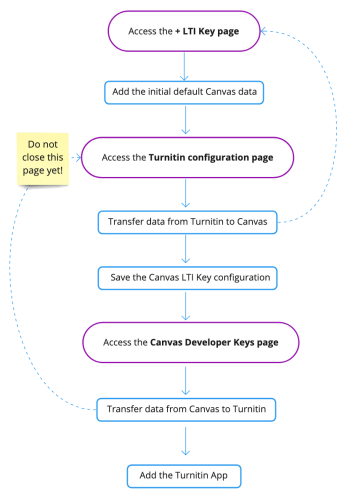
Initial set-up in Canvas
There are a few extra steps required to set-up Turnitin with a self-hosted or Open Source environment that are not needed when Canvas hosted. However, we've worked with Canvas to make this process as simple as possible while ensuring we can replicate the experience you would get in a Canvas hosted environment.
-
Navigate to the Admin page of your Canvas environment, and the open the Developer Keys section.
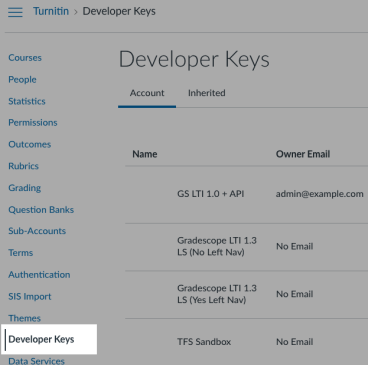
-
On the Account tab, select the + Developer Key button.
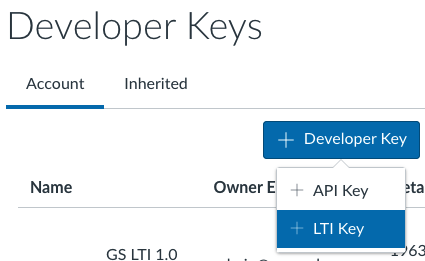
-
From the sub-menu, select the + LTI Key option.
-
A configuration screen will show. There are several fields you can immediately fill in to defaults, and some items that you can only get from the configuration screen in Turnitin.
Field
Change to
Method Use the drop-down to select Manual entry Key Name Create an identifiable name that will be used in the list of developer keys for your account, e.g. Turnitin Redirect URLs https://api.turnitin.com/api/lti/1p3/launch
https://lti.int.turnitin.com/launch
Title Assign a name for the integration that Instructors will use to create a new assignment Description Add any information or notes you'd like to log about the integration. Target Link URL
https://api.turnitin.com/api/lti/1p3/launch
JWK Method Use the drop-down to select Public JWK URL -
The following fields must be sourced from directly within the Turnitin LTI 1.3 set-up screen as these will be unique to your institution. Follow the Finding the Turnitin LTI 1.3 Configuration Page guide to learn how.
Canvas language
Turnitin language
OpenID Connect Initiation URL Login Initiation URL Public JWK URL Tool Public Key set URL
Keep the Turnitin page open once you've set these fields. You'll need it during the next step to add information into Turnitin to complete the connection.
-
In Canvas, expand the LTI Advantage Services section. Certain defaults must be set here for the connection to Turnitin to successfully pass the right data. Select the first seven options, and use the table below to ensure you have selected the correct ones.
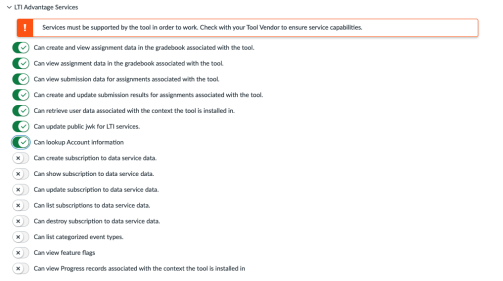
Toggle Option
Correct toggle state
Can create and view assignment data in the gradebook associated with the tool. Active Can view assignment data in the gradebook associated with the tool. Active Can view submission data for assignments associated with the tool. Active
Can create and update submission results for assignments associated with the tool. Active Can retrieve user data associated with the context the tool is installed in. Active Can update public jwk for LTI services. Active
Can lookup Account information
Active
Can create subscription to data service data.
Deactivated
Can show subscription to data service data.
Deactivated
Can update subscription to data service data.
Deactivated
Can list subscriptions to data service data.
Deactivated
Can destroy subscription to data service data.
Deactivated
Can list categorized event types.
Deactivated
Can view feature flags
Deactivated
Can view Progress records associated with the context the tool is installed in
Deactivated
You are now finished with the LTI Advantage Services section and it can be collapsed.
-
Open the Additional Settings section. The only field you need to change here is the Privacy Level from Private to Public.
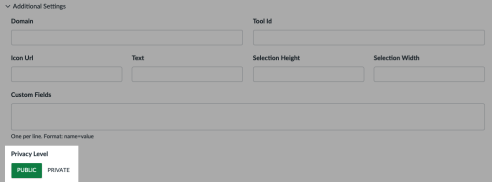
-
Moving to the Placements section, remove of the default options by selecting the X icon in each of the pills.
-
Select the now empty Placement field, and find the Course Assignments Menu option.
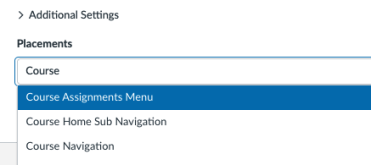
-
On successfully setting the Placement correctly, a new 'Course Assignments Menu' section will appear. Expand this section.
-
From the Course Assignments Menu section, select the LTIDeepLinkingRequest option. All other fields can be left blank.
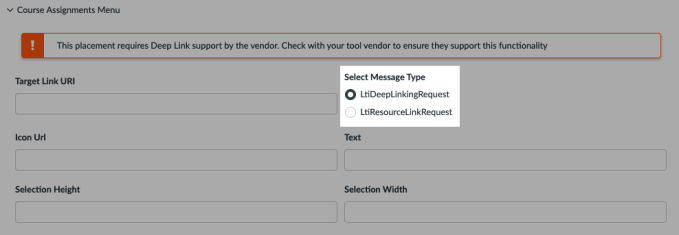
-
All initial Canvas steps are now complete! You'll now need to do the initial steps in Turnitin, and then add the app.
Initial set-up in Turnitin
You can only complete this step if you have kept the same Turnitin page open you used in the Initial Canvas set-up. If you have not kept this page open, you will have to start the process again.
-
Navigate to the Admin page of your Canvas environment, and the open the Developer Keys section.
-
Switch to the Account tab, if it is not already open.

-
Navigate to the LTI Key that you just created. This should be identifiable by the Key Name you gave it.

-
Move the switch for your LTI Key from OFF to ON.
-
You'll be asked to confirm changing the state of the developer key. Select OK to continue.
-
From the Details column, copy the fifteen digit developer key your just activated.
You do not need to use the Show Key button to do this. Simply copy the fifteen digit key.

-
Return to the Turnitin configuration page you should still have open.
-
Navigate to the LMS Details section of the Turnitin configuration page and add the following data.
Turnitin field
Change to
Client ID Paste the fifteen digit LTI Key that you previously copied. Platform public key set URL
https://canvas.instructure.com/api/lti/security/jwks
Issuer
https://canvas.instructure.com
Access token URL
https://canvas.instructure.com/login/oauth2/token
OpenID connect login endpoint
https://canvas.instructure.com/api/lti/authorize_redirect
Platform authorisation provider Leave blank -
Use the Save button to complete the configuration process. Next, you'll Add the Turnitin App to make it available to Instructors in your environment.
Adding the Turnitin App
-
Switch to the Settings section of the Admin page, and select the Apps tab.
-
Select the View App Configurations button.
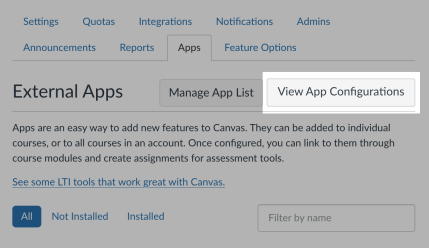
If you already have the Turnitin LTI 1.1 integration configured in your Canvas environment, click View App Configurations, then click the Gear icon for that integration and choose Edit from the dropdown. Rename the tool to Turnitin LTI 1.1. We recommend this so that you can tell the two integrations apart. If you are using both the Canvas Plagiarism Framework integration and the LTI 1.1 integration, the LTI 1.1 integration is the only one that can be renamed.
-
Select the + Add button.
-
Change the Configuration Type to By Client ID.
-
Paste the developer key 170000000000696 into the Client ID field.

-
Select the Submit button.
-
You'll be asked to confirm the app installation. Select the Install button to continue.
-
You've now completed the first step of the registration process. Now, you must create a dummy assignment to initialize the integration with Turnitin.
If you are migrating from LTI 1.1 to LTI 1.3 and would like to test how to access past LTI 1.1 assignments using the LTI 1.3 integration, you can install this integration at the course level. You will follow the same steps below, but use Settings from within the course.
Was this page helpful?
We're sorry to hear that.
